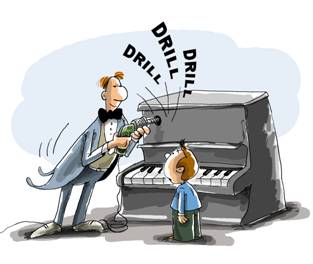 |
|
by Hellene Hiner
A parent asked her child’s piano teacher: ‘My child learned to read very quickly. So tell me, why does he struggle now to read music?”
The Language of the Fingers: It is a common misconception that reading words and reading music notes follow the same process. Children learn to read after they can speak fluently in the same language. But playing piano makes us use our fingers to “speak”, and our fingers are our “voice” and “vocal cords” as well. Do we have an inborn skill to manage our ten fingers the same way that we control our vocal cords? No! For this reason, a piano beginner of whatever age misses the keys and messes up his finger work, just like a baby whose first efforts at speaking begin with babbling his first words. Teaching someone who cannot say a single phrase is not the same as teaching someone who talks like a chatterbox!
Multi-tasking of Fingers and Eyes: Another point to ponder: Five- or six-year old readers are capable of focusing their eyesight on small objects (letters) and shifting their focus along a line of words. They are capable of helping themselves most of the time, by pointing at the line with a finger or a ruler to prevent them from losing track of the words they read. But in piano-playing, there are more than ten black tracks and eleven white ones that a music reader must follow all at once! Piano-playing beginners cannot easily help themselves by pointing, because their fingers are busy with the keys. Maintaining the eye’s focus over all these tracks is a skill singly applied only in the arena of piano playing and chess.
In addition to fingering the keys, a beginner must divide his eyesight between the notations and his hands on the keys. Otherwise, he will not hit the right target! Beginners cannot sneeze or hiccough, fearing that they could lose their position on the keys and never find their way again.
The Job for the Ears: Not every person, child or adult, musically talented or not, can distinguish between the sounds for O and U, and between U and Y. Likewise, not every student can perceive a difference between C and C-sharp. The reason for this is simple: throughout most of his life, a child is busy learning to speak. His early efforts are garbled. For example, he could make sounds to approximate his wish, babbled as “I want candy,” instead producing for him steamed broccoli and carrots! Determining differences between and among sounds develops over time and experience.
